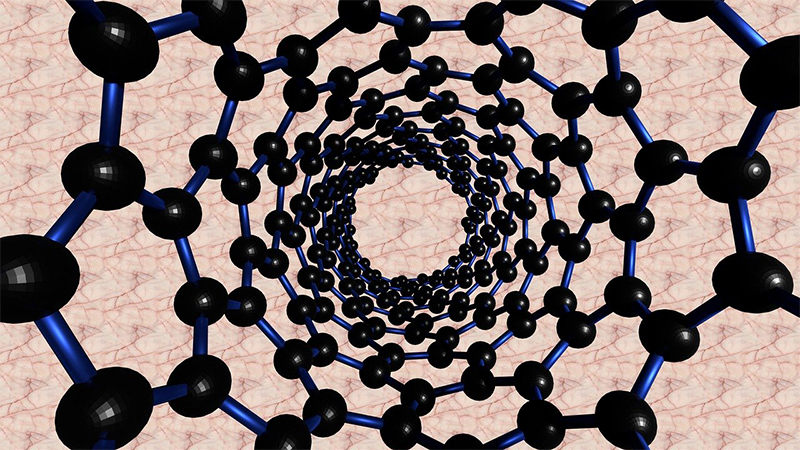June 17, 2020

A team of Mizzou Engineers is turning to artificial intelligence (AI) to help grow and control large quantities of carbon nanotubes—tiny, cylinder-shaped molecules made of rolled sheets of carbon. Using AI is a novel approach to mass producing them, a problem that has plagued scientists for decades. Now, the National Science Foundation is backing the idea with an award funding the group’s research for three years.
When assembled, carbon nanotubes become a flexible, lightweight material that is also strong. It’s so strong, in fact, Iron Man swapped his metal armor with a carbon nanotube suit to defeat the super-mutant Magneto. In real life, some scientists think a carbon nanotube cable could theoretically lift an elevator from earth to space. As for the rest of us, these tiny molecules could someday create all sorts of bendable, unbreakable products.
Carbon nanotubes are relatively easy to grow in a lab. They require certain gasses at extremely high temperatures. But creating large quantities of them while maintaining their beneficial properties is tricky. When these molecules get together, their collective interactions change their properties. Some carbon nanotube populations become hard, while others become rubber-like. The end results are unpredictable. And that makes it tough to manufacture the billions of these nanotubes needed to make a product.

Scientists have been trying to solve this problem since the 1990s. Now, it’s time to let a smarter entity step in, said Kannappan Palaniappan, a professor in electrical engineering and computer science (EECS).
“How many experiments can you do?” he said. “A very small number compared to the space of conformations and properties we want to explore. We want to put AI in the loop. We will let AI guide the experiment and do 100 times more than what one person or lab could do.”
AI-Spy
The project has two sides. Matt Maschmann, an associate professor in mechanical and aerospace engineering, is the lead researcher and looking at production of materials. Palaniappan and others from EECS are providing expertise around AI and computer imaging.
Together, they hope to discover what’s going on when these tiny tubes start to grow and change.

“One unique thing we’re going to bring to the table is our experimental apparatus,” Maschmann said. “We’re going to use a scanning electron microscope as a synthesis system. We will grow carbon nanotubes and watch the process happening in real time. And we’re going to learn a lot by directly observing the process of how nanotubes interact, how those interactions lead to different structural arrangements, and how those structures produce properties we care about.”
Images alone aren’t enough because they don’t provide adequate data. That’s where computer vision comes in, said Filiz Bunyak Ersoy, an assistant research professor.
“We are trying to compute quantitative measures and interpretable data from the images,” Ersoy said. “That will allow us to understand the characteristics of the material. It will also to guide the growth process so desired carbon nanotubes can be processed.”

Armed with that information, Maschmann can adjust the environment in which nanotubes grow to better control properties. For instance, he could change the temperature. Or, he could alter the operating pressure. He can even resize the diameter of the tubes before introducing carbon.
“If we have many small-diameter nanotubes, we’ll get something that’s different than if we have relatively sparse populations of large-diameter nanotubes,” he said. “We can get different products from very similar inputs. That’s what’s challenging about this. We don’t understand the complex interactions between, say, temperature and pressure, and the nanotube population properties we’ll get in the end.”
Thinking Outside of the Tube
The primary work will revolve around carbon nanotubes. But, the research will have broader implications.
The team will share what they learn so that others can replicate the process, said Prasad Calyam, an associate professor in EECS. Calyam will lead the investigations in the project on building an intelligent autonomous research robot for this purpose.

“We will create a knowledge base that will be used for the AI algorithms development to create ideal pathways and autonomously guide computer simulations and scanning electron microscope experiments,” he said. “The knowledge base, along with our AI algorithms, will be accessible for research and training through scientific gateways. And we will provide them in the form of templates so that other people can look at them and adapt them to use in their own context.”
And that could lead to a speedier way to develop other innovative materials.
“Developing any kind of new material takes decades of research and development before it can be launched into applications,” Maschmann said. “The process that we’re developing is generalizable to different material processing systems. The fundamental elements include monitoring a process as it’s evolving and interpreting the data with computer vision and AI. The relationships between process inputs and material outputs are learned using digital tools. As learning increases, process control is increasingly transferred from humans to AI planners. Using this process, we have a goal to increase of rate of research and development by a factor of 10 -100 over what’s possible today.”